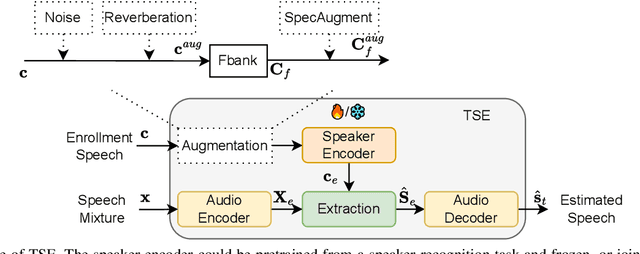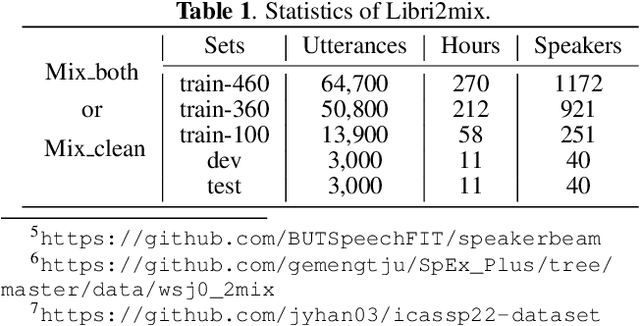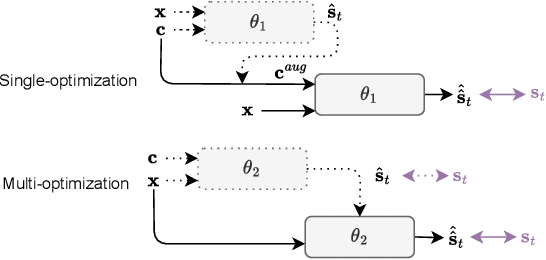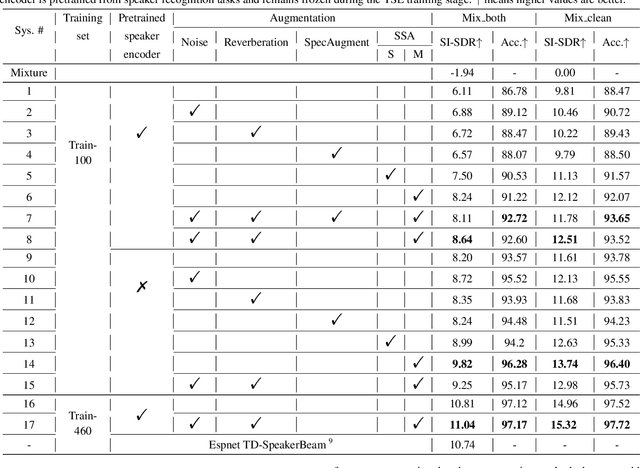Junjie Li
MOSA: Mixtures of Simple Adapters Outperform Monolithic Approaches in LLM-based Multilingual ASR
Aug 26, 2025



Abstract:End-to-end multilingual ASR aims to transcribe speech from different languages into corresponding text, but is often limited by scarce multilingual data. LLM-based ASR aligns speech encoder outputs with LLM input space via a projector and has achieved notable success. However, prior work mainly improves performance by increasing data, with little focus on cross-lingual knowledge sharing. Moreover, a single complex projector struggles to capture both shared and language-specific features effectively. In this work, we propose MOSA (Mixture of Simple Adapters), leveraging a Mixture-of-Experts mechanism to combine lightweight adapters that learn shared and language-specific knowledge. This enables better utilization of high-resource language data to support low-resource languages, mitigating data scarcity issues. Experimental results show that MOSA-Base achieves a 15.4\% relative reduction in average WER compared to the Baseline-Base and consistently outperforms it across all languages. Remarkably, MOSA-Base surpasses the Baseline-Base even when trained with only 60\% of its parameters. Similarly, MOSA-Large outperforms the Baseline-Large in average WER and demonstrates greater robustness to data imbalance. Ablation studies further indicate that MOSA is more effective at handling individual languages and learning both language-specific and shared linguistic knowledge. These findings support that, in LLM-based ASR, a mixture of simple adapters is more effective than a single, complex adapter design.
FISHER: A Foundation Model for Multi-Modal Industrial Signal Comprehensive Representation
Jul 22, 2025Abstract:With the rapid deployment of SCADA systems, how to effectively analyze industrial signals and detect abnormal states is an urgent need for the industry. Due to the significant heterogeneity of these signals, which we summarize as the M5 problem, previous works only focus on small sub-problems and employ specialized models, failing to utilize the synergies between modalities and the powerful scaling law. However, we argue that the M5 signals can be modeled in a unified manner due to the intrinsic similarity. As a result, we propose FISHER, a Foundation model for multi-modal Industrial Signal compreHEnsive Representation. To support arbitrary sampling rates, FISHER considers the increment of sampling rate as the concatenation of sub-band information. Specifically, FISHER takes the STFT sub-band as the modeling unit and adopts a teacher student SSL framework for pre-training. We also develop the RMIS benchmark, which evaluates the representations of M5 industrial signals on multiple health management tasks. Compared with top SSL models, FISHER showcases versatile and outstanding capabilities with a general performance gain up to 5.03%, along with much more efficient scaling curves. We also investigate the scaling law on downstream tasks and derive potential avenues for future works. FISHER is now open-sourced on https://github.com/jianganbai/FISHER
M3Depth: Wavelet-Enhanced Depth Estimation on Mars via Mutual Boosting of Dual-Modal Data
May 20, 2025Abstract:Depth estimation plays a great potential role in obstacle avoidance and navigation for further Mars exploration missions. Compared to traditional stereo matching, learning-based stereo depth estimation provides a data-driven approach to infer dense and precise depth maps from stereo image pairs. However, these methods always suffer performance degradation in environments with sparse textures and lacking geometric constraints, such as the unstructured terrain of Mars. To address these challenges, we propose M3Depth, a depth estimation model tailored for Mars rovers. Considering the sparse and smooth texture of Martian terrain, which is primarily composed of low-frequency features, our model incorporates a convolutional kernel based on wavelet transform that effectively captures low-frequency response and expands the receptive field. Additionally, we introduce a consistency loss that explicitly models the complementary relationship between depth map and surface normal map, utilizing the surface normal as a geometric constraint to enhance the accuracy of depth estimation. Besides, a pixel-wise refinement module with mutual boosting mechanism is designed to iteratively refine both depth and surface normal predictions. Experimental results on synthetic Mars datasets with depth annotations show that M3Depth achieves a significant 16% improvement in depth estimation accuracy compared to other state-of-the-art methods in depth estimation. Furthermore, the model demonstrates strong applicability in real-world Martian scenarios, offering a promising solution for future Mars exploration missions.
Unsupervised anomaly detection in MeV ultrafast electron diffraction
May 19, 2025Abstract:This study focus in the construction of an unsupervised anomaly detection methodology to detect faulty images in MUED. We believe that unsupervised techniques are the best choice for our purposes because the data used to train the detector does not need to be manually labeled, and instead, the machine is intended to detect by itself the anomalies in the dataset, which liberates the user of tedious, time-consuming initial image examination. The structure must, additionally, provide the user with some measure of uncertainty in the detection, so the user can take decisions based on this measure.
Enhancing Multi-Agent Systems via Reinforcement Learning with LLM-based Planner and Graph-based Policy
Mar 13, 2025Abstract:Multi-agent systems (MAS) have shown great potential in executing complex tasks, but coordination and safety remain significant challenges. Multi-Agent Reinforcement Learning (MARL) offers a promising framework for agent collaboration, but it faces difficulties in handling complex tasks and designing reward functions. The introduction of Large Language Models (LLMs) has brought stronger reasoning and cognitive abilities to MAS, but existing LLM-based systems struggle to respond quickly and accurately in dynamic environments. To address these challenges, we propose LLM-based Graph Collaboration MARL (LGC-MARL), a framework that efficiently combines LLMs and MARL. This framework decomposes complex tasks into executable subtasks and achieves efficient collaboration among multiple agents through graph-based coordination. Specifically, LGC-MARL consists of two main components: an LLM planner and a graph-based collaboration meta policy. The LLM planner transforms complex task instructions into a series of executable subtasks, evaluates the rationality of these subtasks using a critic model, and generates an action dependency graph. The graph-based collaboration meta policy facilitates communication and collaboration among agents based on the action dependency graph, and adapts to new task environments through meta-learning. Experimental results on the AI2-THOR simulation platform demonstrate the superior performance and scalability of LGC-MARL in completing various complex tasks.
MoMuSE: Momentum Multi-modal Target Speaker Extraction for Real-time Scenarios with Impaired Visual Cues
Dec 11, 2024Abstract:Audio-visual Target Speaker Extraction (AV-TSE) aims to isolate the speech of a specific target speaker from an audio mixture using time-synchronized visual cues. In real-world scenarios, visual cues are not always available due to various impairments, which undermines the stability of AV-TSE. Despite this challenge, humans can maintain attentional momentum over time, even when the target speaker is not visible. In this paper, we introduce the Momentum Multi-modal target Speaker Extraction (MoMuSE), which retains a speaker identity momentum in memory, enabling the model to continuously track the target speaker. Designed for real-time inference, MoMuSE extracts the current speech window with guidance from both visual cues and dynamically updated speaker momentum. Experimental results demonstrate that MoMuSE exhibits significant improvement, particularly in scenarios with severe impairment of visual cues.
GiVE: Guiding Visual Encoder to Perceive Overlooked Information
Oct 26, 2024Abstract:Multimodal Large Language Models have advanced AI in applications like text-to-video generation and visual question answering. These models rely on visual encoders to convert non-text data into vectors, but current encoders either lack semantic alignment or overlook non-salient objects. We propose the Guiding Visual Encoder to Perceive Overlooked Information (GiVE) approach. GiVE enhances visual representation with an Attention-Guided Adapter (AG-Adapter) module and an Object-focused Visual Semantic Learning module. These incorporate three novel loss terms: Object-focused Image-Text Contrast (OITC) loss, Object-focused Image-Image Contrast (OIIC) loss, and Object-focused Image Discrimination (OID) loss, improving object consideration, retrieval accuracy, and comprehensiveness. Our contributions include dynamic visual focus adjustment, novel loss functions to enhance object retrieval, and the Multi-Object Instruction (MOInst) dataset. Experiments show our approach achieves state-of-the-art performance.
Multi-Level Speaker Representation for Target Speaker Extraction
Oct 21, 2024Abstract:Target speaker extraction (TSE) relies on a reference cue of the target to extract the target speech from a speech mixture. While a speaker embedding is commonly used as the reference cue, such embedding pre-trained with a large number of speakers may suffer from confusion of speaker identity. In this work, we propose a multi-level speaker representation approach, from raw features to neural embeddings, to serve as the speaker reference cue. We generate a spectral-level representation from the enrollment magnitude spectrogram as a raw, low-level feature, which significantly improves the model's generalization capability. Additionally, we propose a contextual embedding feature based on cross-attention mechanisms that integrate frame-level embeddings from a pre-trained speaker encoder. By incorporating speaker features across multiple levels, we significantly enhance the performance of the TSE model. Our approach achieves a 2.74 dB improvement and a 4.94% increase in extraction accuracy on Libri2mix test set over the baseline.
WeSep: A Scalable and Flexible Toolkit Towards Generalizable Target Speaker Extraction
Sep 24, 2024



Abstract:Target speaker extraction (TSE) focuses on isolating the speech of a specific target speaker from overlapped multi-talker speech, which is a typical setup in the cocktail party problem. In recent years, TSE draws increasing attention due to its potential for various applications such as user-customized interfaces and hearing aids, or as a crutial front-end processing technologies for subsequential tasks such as speech recognition and speaker recongtion. However, there are currently few open-source toolkits or available pre-trained models for off-the-shelf usage. In this work, we introduce WeSep, a toolkit designed for research and practical applications in TSE. WeSep is featured with flexible target speaker modeling, scalable data management, effective on-the-fly data simulation, structured recipes and deployment support. The toolkit is publicly avaliable at \url{https://github.com/wenet-e2e/WeSep.}
On the effectiveness of enrollment speech augmentation for Target Speaker Extraction
Sep 15, 2024



Abstract:Deep learning technologies have significantly advanced the performance of target speaker extraction (TSE) tasks. To enhance the generalization and robustness of these algorithms when training data is insufficient, data augmentation is a commonly adopted technique. Unlike typical data augmentation applied to speech mixtures, this work thoroughly investigates the effectiveness of augmenting the enrollment speech space. We found that for both pretrained and jointly optimized speaker encoders, directly augmenting the enrollment speech leads to consistent performance improvement. In addition to conventional methods such as noise and reverberation addition, we propose a novel augmentation method called self-estimated speech augmentation (SSA). Experimental results on the Libri2Mix test set show that our proposed method can achieve an improvement of up to 2.5 dB.
 Add to Chrome
Add to Chrome Add to Firefox
Add to Firefox Add to Edge
Add to Edge